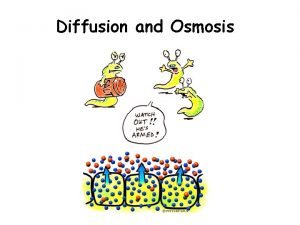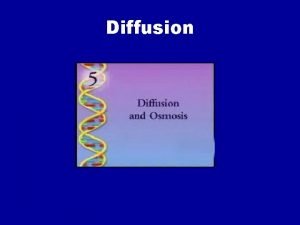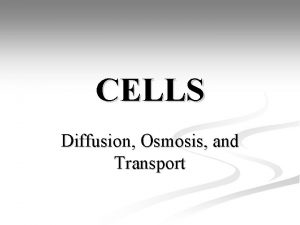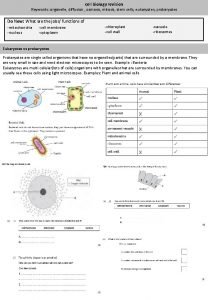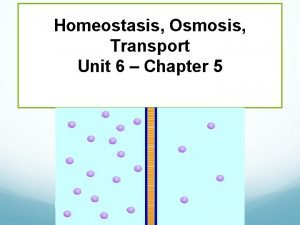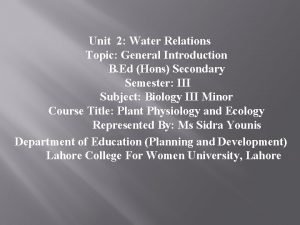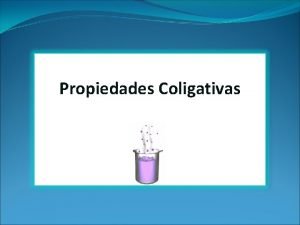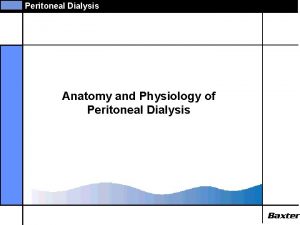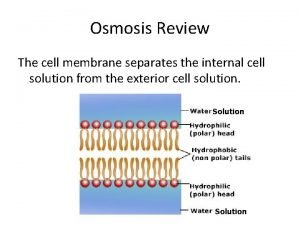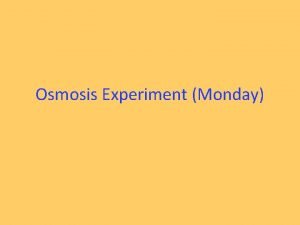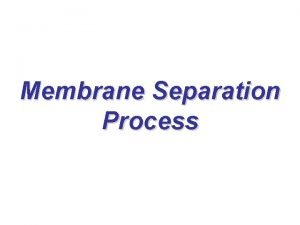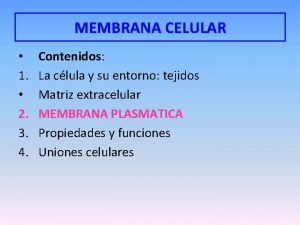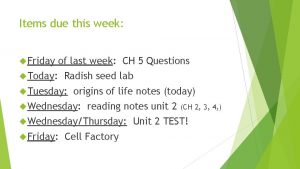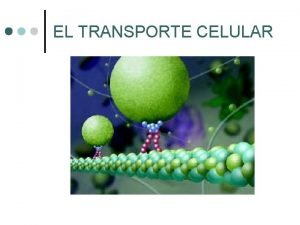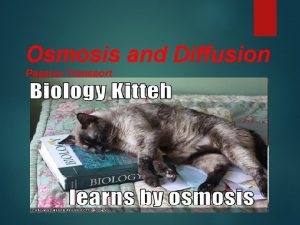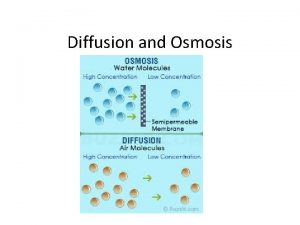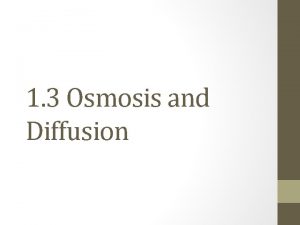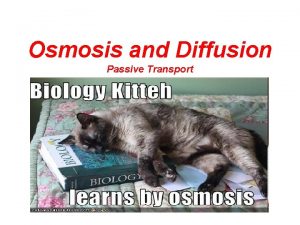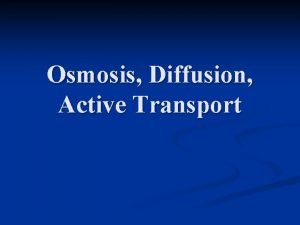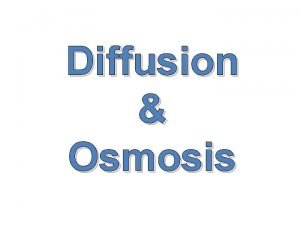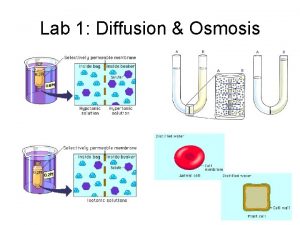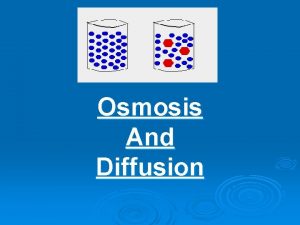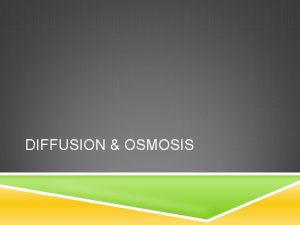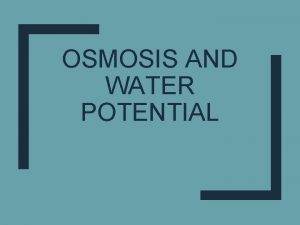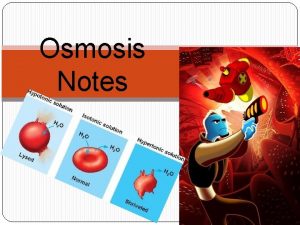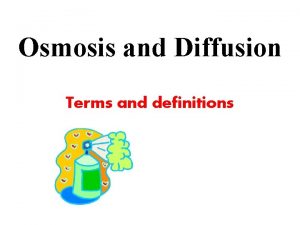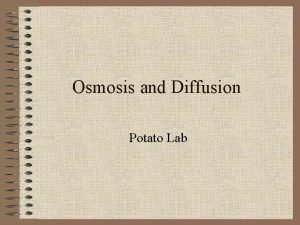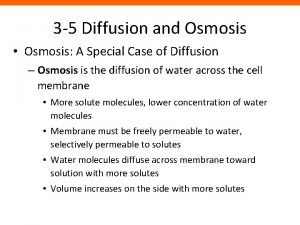Diffusion and Osmosis Diffusion Section 6 2 Osmosis



















- Slides: 19

Diffusion and Osmosis Diffusion: Section 6. 2 Osmosis: Section 8. 1

Biology 10/29/13 Mrs. Turgeon DO NOW: 1. Get out your cell lab worksheet 2. In your notes: Describe one difference between an animal cell and a plant cell. AGENDA: 1. Finish part F of cell lab as a group 2. Take notes on diffusion and osmosis REMINDERS: 1. Science Club today after school, room 312! 2. Science Fair judges still needed

Objective • SWBAT explain how molecules are transported across the cell membrane.

Diffusion The net movement of molecules from an area of higher concentration to an area of lower concentration.

Diffusion • Diffusion results because of the random movement of particles. • Three key factors: concentration, temperature, pressure affect the rate of diffusion. • Equilibrium is reached when there is an even distribution of solute molecules (water) 1 2 3 4

Osmosis The diffusion of water across a selectively permeable membrane.

Osmosis In a cell, water always moves to reach an equal concentration on both sides of the cell membrane.

Osmosis The direction of osmosis depends on relative concentrations of dissolved particles on the two sides of the membrane.

Direction of Osmosis • Isotonic Solution – concentration of dissolved particles outside and inside the cell are equal. – there will be no net movement* of water. *water diffuses into and out of the cell at equal rates.

Direction of Osmosis • Hyptertonic Solution – concentration of dissolved particles outside the cell is higher than in the cytosol. – water will diffuse out of the cell.

Direction of Osmosis • Hypotonic Solution – concentration of dissolved particles outside the cell is lower than in the cytosol. – water will diffuse in to the cell.


Chapter 5 How Cells deal with Osmosis To remain alive, cells must compensate for the water that enters the cell in hypotonic environments and leaves the cell in hypertonic environments.

Passive Transport • Movement of molecules across the cell membrane • Does NOT require energy • Examples: diffusion and osmosis

Facilitated Diffusion • Passive transport of materials across the cell membrane using transport proteins. • Examples: – Carrier Proteins – Ion Channels

Chapter 5 Facilitated Diffusion

Chapter 5 Active Transport • Movement of particles across the cell membrane against the concentration gradient – (lower concentration higher concentration) • Requires ENERGY!!! • Example: – Carrier proteins, endocytosis, exocytosis

Chapter 5 Active Transport • Endocytosis – Cells ingest external materials by folding around them and forming a pouch. • Engulfs bacteria, food etc.

Chapter 5 Active Transport • Exocytosis – Excretion of materials from a cell. • Expels wastes, hormones etc.
 Diffusion and osmosis
Diffusion and osmosis Plant cells isotonic
Plant cells isotonic Types of diffusion
Types of diffusion Diffusion osmosis
Diffusion osmosis Diffusion vs facilitated diffusion
Diffusion vs facilitated diffusion Relocation diffusion diagram
Relocation diffusion diagram Osmosis water and salt
Osmosis water and salt Water potential equation
Water potential equation Importance of osmosis
Importance of osmosis Difusion simple
Difusion simple Osmosis tattoo
Osmosis tattoo Temperatura de congelacion
Temperatura de congelacion Dialysis vs osmosis
Dialysis vs osmosis Hypotonic
Hypotonic Research question for osmosis experiment
Research question for osmosis experiment Nanofiltration vs reverse osmosis
Nanofiltration vs reverse osmosis Osmosis equation
Osmosis equation Glucocalix funcion
Glucocalix funcion Water potential examples
Water potential examples Moleculas de agua
Moleculas de agua
